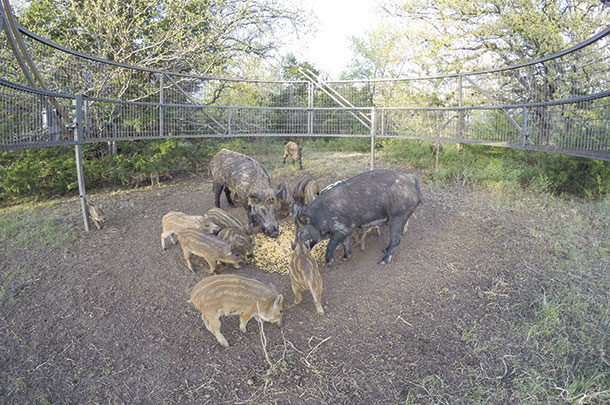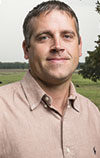Although feral pigs cause plenty of damage to native ecosystems and agricultural land, we must let go of the philosophy that any pig removed is progress toward solving the problem.
To be good stewards of the land and maintain economic viability, successful management of feral pigs requires discipline in using best management practices and continued innovation to focus control at the population level rather than the individual pig level.
Hunting continues to be touted as a necessary technique to achieve feral pig eradication. However, even with the most sophisticated equipment (e.g., suppressors and night vision), hunting is rarely considered a control option but recreation instead. Recreational hunters in Oklahoma may harvest 300,000 feral pigs annually, but when compared to current population levels in excess of one million and considering reproduction, harvesting portions of sounders (family groups of pigs) does little for damage mitigation or even short-term population reduction.
Another sad reality is the fact that many land managers gravitate to the cheapest or easiest option for pig control first, which is often a personal firearm or small, homemade trap. Today, animal-activated box and corral traps litter the landscape in Oklahoma and Texas. Their close resemblance to grazing exclosures can illustrate their usefulness. These techniques were often used to capture a handful of pigs, but when trap-wary feral pigs discontinued use of permanent trap locations, those traps were often forgotten and grew up with vegetation.
Integrating multiple techniques is a common recommendation for elevated population control. But some techniques like the aforementioned can be more harmful rather than helpful to the overall control of a population. Research suggests we must remove approximately 70 percent of the population annually to maintain status quo. In light of this overwhelming statistic, feral pig control efforts should not be a simple integration of techniques, but a strategic implementation of techniques.
Today, only the most disciplined and experienced trappers find success with conventional trapping techniques (e.g., animal-activated box and corral traps). Similar to the genetic manipulation through selective breeding that resulted in rapid growth rates, high reproductive potential and physical appearances of various breeds of domestic pigs, undisciplined trappers select for trap wariness characteristics in feral pigs. For instance, when a trap is actuated and captures five pigs from a sounder of 20, it’s often the five most naive pigs removed from the population while the 15 most wary individuals survive and contribute to future generations of feral pigs.
The introduction of human-activated options for corral traps was a game changer when it came to trapping entire sounders. These technologies allowed the user to have complete control of when the trap was triggered. This resulted in complete elimination of non-target captures (e.g., white-tailed deer or raccoons) and a much higher capture rate of feral pigs. Many professional trappers started using this technology and claimed it doubled their capture rate. Because these traps were enclosures at ground level, some of the most wary pigs still avoided entering traps.
The BoarBuster trap system developed by the Noble Research Institute redefined the corral trap by completely suspending it and incorporating a cellular-activated trigger that could be monitored in real time by a user anywhere in the world. Technologies like Noble’s technology have elevated pig control to capture rates as high as 88 percent and are finally impacting pig populations. These newer and more effective options come with a higher initial price tag, but pay for themselves quickly when the price of repeated pig damage and ongoing trapping efforts are considered.
Outside of cellular-activated traps, very few other techniques consistently remove 70 percent. Aerial gunning can be a highly effective option for landowners or groups with large open tracts, but wildlife services’ flights are a considerable governmental expense and in high demand. Consequently, aerial gunning activities seldom occur at the time landowners request it and need it. Some states permit outfitters to offer recreational hunts from helicopters. However, a paying hunter is often less effective than a trained aerial gunner.
Experimental testing is ongoing in the development of feral pig toxicants in the U.S. There are currently no registered legal toxicants for use on feral pigs in the U.S., but they are coming. Many agricultural producers see toxicants as the silver bullet to feral pig control, but those expectations are unrealistic.
Any toxicant released for feral pigs will carry very specific labeled requirements, and one of those will be a species-specific delivery system. This system is currently contemplated to be a feeder that allows pigs to physically lift the lid, but excludes non-target animals. I urge producers not to wait for this technology. If a pig can be taught to lift a lid to eat, it can be taught to walk in a trap to eat. Toxicants will likely be somewhat less effective than proper trapping but will be a low-cost option for pig control.
Feral pigs are a problem that will not just go away. Conservative management practices (e.g., fencing and scare tactics) that favor feral pigs and wildlife coexisting are irresponsible and inhumane to the native species that evolved on these landscapes. Conventional trapping techniques exacerbate the problem by continually educating populations of destructive pigs. Population level reduction will require strategic and disciplined implementation of new and effective techniques and collaboration among neighbors.
For more information about feral hogs, visit Noble Research Institute - Feral hogsoble Research Institute - Feral hogs. ![]()
PHOTO: New corral systems can improve the ability to capture not just naive pigs in a sounder, but the most wary ones as well. Photo courtesy of Noble Research Institute.

-
Josh Gaskamp
- Wildlife and Fisheries Consultant
- Noble Research Institute
- Email Josh Gaskamp








